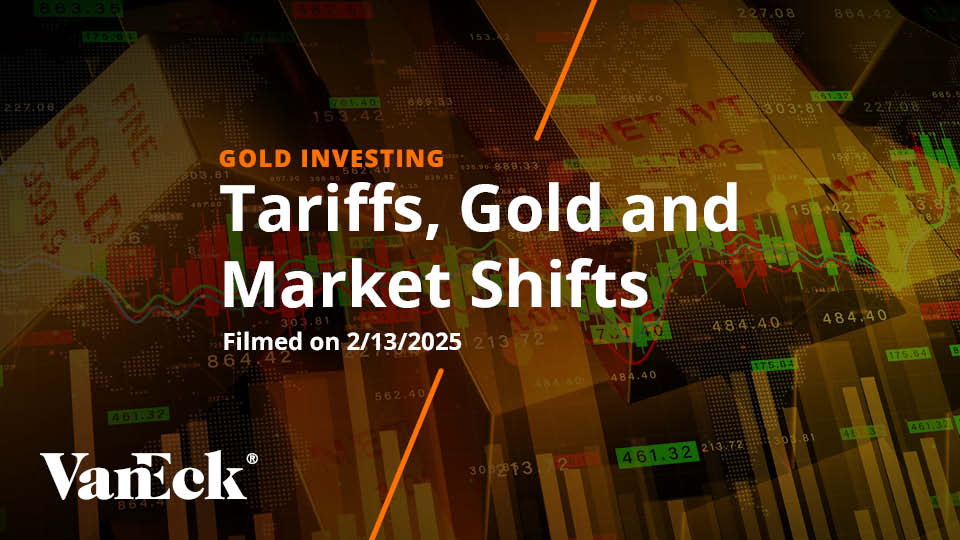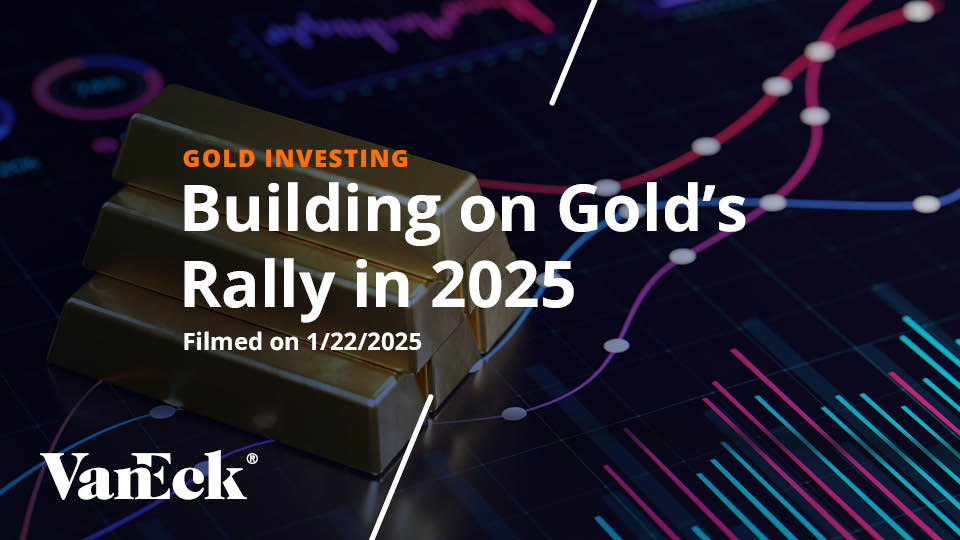Will Investors Follow Central Banks into Gold?
13 February 2023
Read Time 7 MIN
Monthly gold market and economic insights from Imaru Casanova, Deputy Portfolio Manager and Joe Foster, Portfolio Manager and Strategist, featuring their unique views on mining and gold’s portfolio benefits.
Gold had a strong start to the year. The main headwind for gold for most of 2022 was the strength of the U.S. dollar. However, in January, expectations for a slowdown in the U.S. Federal Reserve’s (Fed’s) rate hiking pace, combined with increased concerns about economic growth, put pressure on the U.S. dollar and supported gold. As treasury yields plunged, gold rallied, trading above $1,900 per ounce on January 13. Gold held steady at these levels, despite a mix of economic news, quietly trading up to a high of $1,949 on January 26. Gold closed at $1,928 on January 31, up 5.7%, a significant $104 per ounce move during the first month of the year.
Gold equities demonstrated they are a leveraged play on gold. The NYSE Arca Gold Miners Index (GDMNTR)1 was up 11.4% and the MVIS Global Juniors Gold Miners Index (MVGDXJTR)2 was up 9.3% for the month. Despite the strong monthly gains, gold equities continue to be undervalued relative to the metal and we expect this to result in their continued outperformance this year. Cost inflation hit the miners hard last year, with all-in sustaining costs increasing by more than 10% in 2022 compared to 2021. In February, gold miners will provide production and cost guidance for 2023. We would not be surprised to see higher operating costs again in 2023, but as inflation pressures abate, we expect the year-on-year increase will be much less than in 2022. Capital expenses related to deferrals in previous years or due to mine sequencing may also contribute to higher all-in sustaining costs in 2023. Higher gold prices this year could defend the miners’ margins. For example, the current gold price is approximately $125 per ounce higher than the average gold price last year of $1,802 per ounce. If sustained, these gold price gains would significantly exceed estimated cost increases in 2023, leading to margin expansion and higher valuations for gold miners.
Central banks banking on gold
The World Gold council published 2022 gold demand statistics that estimated another record quarter of central bank gold purchases in the fourth quarter. Central bank net purchases in Q4 totaled 417 tonnes, taking second half of 2022 total buying to 862 tonnes. At 1,135 tonnes, 2022 was the second highest year of net central bank gold buying on record since 1950. Since 2010 and for 13 consecutive years, central banks have been net buyers of gold.
Second highest year of central bank net purchases since 1950
Source: World Gold Council. Data as of January 2023.
The World Gold Council’s most recent central bank gold survey reveals the main reasons behind the banks’ decisions to own gold: its performance during times of crisis, its role as a long term store of value and its high liquidity. VanEck’s Chief Economist, Emerging Markets Fixed Income, Natalia Gurushina, recently highlighted in her daily morning note, an IMF research paper on gold that is “too good to ignore”. The IMF report, Gold as International Reserves: A Barbarous Relic No More?*, reiterates the argument that this recent impetus by central banks to buy gold derives from gold’s appeal as a safe haven in periods of economic, financial and geopolitical volatility. Its role as an inflation hedge, portfolio diversifier and the fact it is favored by custom and tradition are also mentioned. The IMF research also shows that the imposition of financial sanctions (think of those imposed on Russia after its invasion of Ukraine) by the main reserve-issuing economies is also correlated to the increase in the share of central bank reserves held in gold.
We anticipated that central banks would be closely watching Russia’s experience as it related to its foreign reserves, and that this would support central bank buying in 2022. The actual figures surpassed our expectations. We expect central banks to remain net buyers of gold in 2023 and longer.
Gold has held up better than you would think
During our most recent quarterly webinar, we said that it feels as if investors need to be “scared into” owning gold. What we meant is that most investors seem uninterested in gold until things get ugly. Well, things got really ugly last year, and central banks took note, so you may say that they, too, got scared into owning gold, accelerating their purchases to record levels. Could the attitude of central banks towards gold be paving the way for investors more broadly? A track record of 13 years of consecutive net buying demonstrates that as a group these institutions are not trying to “time” the gold market. Their commitment to gold appears to be long term and based on gold’s key attributes as a safe haven and portfolio diversifier. We, too, believe that gold, rather than being viewed as an asset of last resort, should be considered a core component and enjoy a permanent allocation in any portfolio. In our engagements, we find that many investors are surprised by gold’s performance over time. Gold, while no doubt a relic, is hardly barbarous after all.
Gold has performed well on a relative basis over the last 30-years
Source: IMF, VanEck. Data as of December 2022. “Global Stocks” represented by MSCI AC World Index GR3. “Global Bonds” represented by Bloomberg Global Aggregate Bond Index TR4. “Commodities” represented by Bloomberg Commodity Index TR5. “U.S. Cash” represented by ICE BofA U.S. 3-Month Treasury Bill TR6.
Fed policy, recession fears lending further support for gold
As we enter 2023, it seems the market’s concerns around economic growth, both in the U.S. and globally, are starting to intensify, providing support for gold prices. The big problems for gold in 2022 were the Fed and the U.S. dollar. It is fair to say the Fed is likely approaching the end of the hiking cycle and the market is currently pricing in only two more small (25 bps) hikes. This is primarily fueled by inflation appearing to be heading lower, and some weakness in economic indicators suggesting that Fed policies are starting to take hold.
We have been saying that gold can rally well ahead of a Fed pause or pivot as the market becomes more certain that the end of the hike cycle is approaching. That is what we are seeing this year – gold trading up as the dollar weakens in anticipation of a pause. The reversal of the strong dollar trend of 2022 should be an important driver of gold prices in 2023. China’s re-opening is likely another strong driver. Gold stands to benefit from both scenarios: increased demand out of China (the largest consumer of gold) because of a strong economic recovery; or increased investment safe haven demand if the recovery is softer or slower impacting global growth. While an economic recession seems increasingly more likely, several other conditions may be required before we see investors jump to the safety of gold. These include a significantly weaker jobs market and higher unemployment rate; a drop in corporate earnings and a deeper correction of the equity markets; and/or sustained inflation above the Fed’s target rate. All of these conditions are supportive of gold.
What happens when investment demand returns?
The lack of investment demand for gold is evident by looking at the movements in global gold bullion ETF holdings. There is a strong positive correlation between the gold price and the holdings of gold ETFs. However, since the end of October the gold price has increased $295 per ounce (18%) while ETF holdings have declined by 1.7%.
Gold has done well recently without any investment demand (which has typically been a significant driver)
Source: Bloomberg. Data as of January 2023.
Historically, it is investment demand that drives the gold price higher, with other centers of demand (or supply, for that matter) helping set a floor to the gold price. We view this recent strength in the gold price, despite a lack of ETF demand, as positive for the gold market, in that it sets a very solid level for gold (and importantly for gold miners). Are central banks picking up the gold market slack left by other investors? Will they too become a more influential driver of gold prices as they continue to accumulate gold more actively? While ETF inflows are still lacking, a pick-up in investment demand should intensify gold’s breakout. We see potential for gold to reach its all-time highs of over $2,000 per ounce in 2023.
Related Insights
IMPORTANT DEFINITIONS & DISCLOSURES
This material may only be used outside of the United States.
This is not an offer to buy or sell, or a recommendation of any offer to buy or sell any of the securities mentioned herein. Fund holdings will vary. For a complete list of holdings in VanEck Mutual Funds and VanEck ETFs, please visit our website at www.vaneck.com.
The information presented does not involve the rendering of personalized investment, financial, legal, or tax advice. Certain statements contained herein may constitute projections, forecasts and other forward looking statements, which do not reflect actual results. Information provided by third-party sources are believed to be reliable and have not been independently verified for accuracy or completeness and cannot be guaranteed. Any opinions, projections, forecasts, and forward-looking statements presented herein are valid as of the date of this communication and are subject to change without notice. The information herein represents the opinion of the author(s), but not necessarily those of VanEck.
The views contained herein are not to be taken as advice or a recommendation to buy or sell any investment in any jurisdiction, nor is it a commitment from Van Eck Associates Corporation or its subsidiaries to participate in any transactions in any companies mentioned herein. This content is published in the United States. Investors are subject to securities and tax regulations within their applicable jurisdictions that are not addressed herein.
All investing is subject to risk, including the possible loss of the money you invest. As with any investment strategy, there is no guarantee that investment objectives will be met and investors may lose money. Diversification does not ensure a profit or protect against a loss in a declining market. Past performance is no guarantee of future results.


